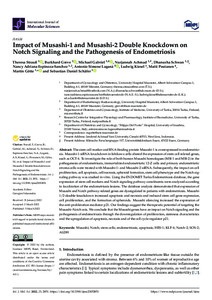Impact of Musashi-1 and Musashi-2 Double Knockdown on Notch Signaling and the Pathogenesis of Endometriosis
Strauss Theresa; Greve Burkhard; Gabriel Michael; Achmad Nurjannah; Schwan Dhanusha; Espinoza-Sanchez Nancy Adriana; Lagana Antonio Simone; Kiesel Ludwig; Poutanen Matti; Goette Martin; Schaefer Sebastian Daniel
Impact of Musashi-1 and Musashi-2 Double Knockdown on Notch Signaling and the Pathogenesis of Endometriosis
Strauss Theresa
Greve Burkhard
Gabriel Michael
Achmad Nurjannah
Schwan Dhanusha
Espinoza-Sanchez Nancy Adriana
Lagana Antonio Simone
Kiesel Ludwig
Poutanen Matti
Goette Martin
Schaefer Sebastian Daniel
MDPI
Julkaisun pysyvä osoite on:
https://urn.fi/URN:NBN:fi-fe2022081155021
https://urn.fi/URN:NBN:fi-fe2022081155021
Tiivistelmä
The stem cell marker and RNA-binding protein Musashi-1 is overexpressed in endometriosis. Musashi-1-siRNA knockdown in Ishikawa cells altered the expression of stem cell related genes, such as OCT-4. To investigate the role of both human Musashi homologues (MSI-1 and MSI-2) in the pathogenesis of endometriosis, immortalized endometriotic 12-Z cells and primary endometriotic stroma cells were treated with Musashi-1- and Musashi-2-siRNA. Subsequently, the impact on cell proliferation, cell apoptosis, cell necrosis, spheroid formation, stem cell phenotype and the Notch signaling pathway was studied in vitro. Using the ENDOMET Turku Endometriosis database, the gene expression of stem cell markers and Notch signaling pathway constituents were analyzed according to localization of the endometriosis lesions. The database analysis demonstrated that expression of Musashi and Notch pathway-related genes are dysregulated in patients with endometriosis. Musashi-1/2-double-knockdown increased apoptosis and necrosis and reduced stem cell gene expression, cell proliferation, and the formation of spheroids. Musashi silencing increased the expression of the anti-proliferation mediator p21. Our findings suggest the therapeutic potential of targeting the Musashi-Notch axis. We conclude that the Musashi genes have an impact on Notch signaling and the pathogenesis of endometriosis through the downregulation of proliferation, stemness characteristics and the upregulation of apoptosis, necrosis and of the cell cycle regulator p21.
Kokoelmat
- Rinnakkaistallenteet [27094]
